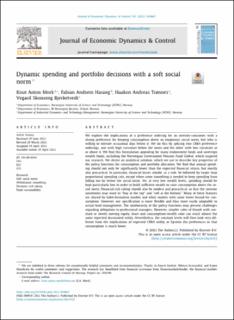| dc.contributor.author | Mork, Knut Anton | |
| dc.contributor.author | Harang, Fabian Andsem | |
| dc.contributor.author | Trønnes, Haakon Andreas | |
| dc.contributor.author | Bjerketvedt, Vegard Skonseng | |
| dc.date.accessioned | 2023-08-17T05:51:31Z | |
| dc.date.available | 2023-08-17T05:51:31Z | |
| dc.date.created | 2023-05-30T09:45:38Z | |
| dc.date.issued | 2023 | |
| dc.identifier.citation | Journal of Economic Dynamics and Control. 2023, 151 . | en_US |
| dc.identifier.issn | 0165-1889 | |
| dc.identifier.uri | https://hdl.handle.net/11250/3084481 | |
| dc.description.abstract | We explore the implications of a preference ordering for an investor-consumer with a strong preference for keeping consumption above an exogenous social norm, but who is willing to tolerate occasional dips below it. We do this by splicing two CRRA preference orderings, one with high curvature below the norm and the other with low curvature at or above it. We find this formulation appealing for many endowment funds and sovereign wealth funds, including the Norwegian Government Pension Fund Global, which inspired our research. We derive an analytical solution, which we use to describe key properties of the policy functions for consumption and portfolio allocation. We find that annual spending should not only be significantly lower than the expected financial return, but mostly also procyclical. In particular, financial losses should, as a rule, be followed by larger than proportional spending cuts, except when some smoothing is needed to keep spending from falling too far below the social norm. Yet, at very low wealth levels, spending should be kept particularly low in order to build sufficient wealth to raise consumption above the social norm. Financial risk taking should also be modest and procyclical, so that the investor sometimes may want to “buy at the top” and “sell at the bottom.” Many of these features are shared by habit-formation models and other models with some lower bound for consumption. However, our specification is more flexible and thus more easily adaptable to actual fund management. The nonlinearity of the policy functions may present challenges regarding delegation to professional managers. However, simpler rules of thumb with constant or slowly moving equity share and consumption-wealth ratio can reach almost the same expected discounted utility. Nevertheless, the constant levels will then look very different from the implications of expected CRRA utility or Epstein–Zin preferences in that consumption is much lower. | en_US |
| dc.language.iso | eng | en_US |
| dc.publisher | Elsevier | en_US |
| dc.rights | Navngivelse 4.0 Internasjonal | * |
| dc.rights.uri | http://creativecommons.org/licenses/by/4.0/deed.no | * |
| dc.subject | Soft social norm | en_US |
| dc.subject | Withdrawal smoothing | en_US |
| dc.subject | Dynamic risk taking | en_US |
| dc.subject | Fund sustainability | en_US |
| dc.title | Dynamic spending and portfolio decisions with a soft social norm | en_US |
| dc.title.alternative | Dynamic spending and portfolio decisions with a soft social norm | en_US |
| dc.type | Peer reviewed | en_US |
| dc.type | Journal article | en_US |
| dc.description.version | publishedVersion | en_US |
| dc.rights.holder | The Authors | en_US |
| dc.source.pagenumber | 0 | en_US |
| dc.source.volume | 151 | en_US |
| dc.source.journal | Journal of Economic Dynamics and Control | en_US |
| dc.identifier.doi | 10.1016/j.jedc.2023.104667 | |
| dc.identifier.cristin | 2150055 | |
| cristin.ispublished | true | |
| cristin.fulltext | original | |
| cristin.qualitycode | 1 | |

